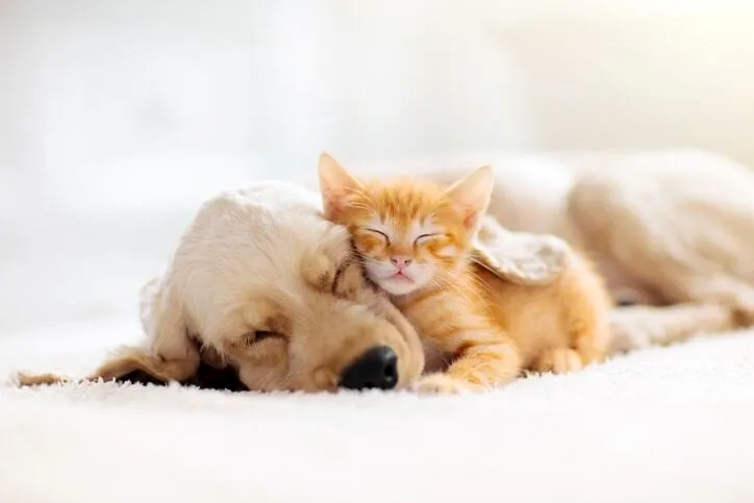
The Importance of Mental Stimulation for Pets
Pets hold a special place in our hearts, and as responsible pet owners, it’s essential to ensure their overall well-being. While providing food, shelter, and medical care is crucial, one aspect that often gets overlooked is mental stimulation for pets. Just like humans, pets require mental exercise to stay healthy and happy. In this article, we’ll delve into the importance of mental stimulation for pets and explore various ways to incorporate it into their daily lives.
Read More: Mental Health Benefits of Dogs and Cats
Understanding Mental Stimulation for Pets

What is Mental Stimulation?
Mental stimulation refers to activities that engage a pet’s brain, keeping them mentally active and challenged. It involves providing opportunities for problem-solving, exploration, and learning new skills. These activities are essential for promoting cognitive function and preventing boredom in pets.
Why is it Important for Pets?
Mental stimulation is vital for pets because it helps prevent behavioral problems such as boredom, anxiety, and depression. Just like humans, pets can experience mental health issues if their minds are not adequately stimulated. Additionally, mental exercise can enhance their overall quality of life and strengthen the bond between pets and their owners.
Benefits of Mental Stimulation for Pets
Mental Health Improvement
Engaging in mentally stimulating activities can significantly improve a pet’s mental health. It reduces stress and anxiety levels, promotes relaxation, and enhances their overall mood. Pets that receive regular mental stimulation for pets are less likely to develop behavioral issues and are generally happier and more content.
Physical Health Enhancement
Interestingly, mental stimulation for pets can also have physical health benefits for pets. Activities that challenge their minds often involve physical movement, leading to increased exercise and better overall fitness. For example, interactive toys that require problem-solving skills can encourage pets to move around and stay active.
Behavior Management
One of the most significant benefits of mental stimulation for pets is its role in behavior management. Pets that are mentally stimulated are less likely to engage in destructive behaviors such as chewing, scratching, or excessive barking. By keeping their minds occupied, pet owners can effectively manage and prevent unwanted behaviors.
Ways to Provide Mental Stimulation
Interactive Toys
Interactive toys are an excellent way to provide mental stimulation for pets. These toys are designed to challenge pets’ minds and keep them entertained for hours. Examples include puzzle feeders, treat-dispensing toys, and interactive games that require problem-solving skills.
Training Sessions
Training sessions are not only an opportunity to teach pets new skills but also a form of mental stimulation for pets. Teaching commands, tricks, and obedience training exercises can keep pets mentally engaged and stimulated. Plus, it strengthens the bond between pets and their owners through positive reinforcement.
Enriched Environment
Creating an enriched environment for pets is essential for mental stimulation. This involves providing opportunities for exploration and sensory stimulation. Adding climbing structures, hiding spots, and interactive play areas can encourage pets to engage in natural behaviors and keep their minds active.
Socialization
Socialization is another critical aspect of mental stimulation, especially for social animals like dogs and cats. Regular interaction with other pets and humans provides mental and emotional stimulation, preventing loneliness and boredom. Organizing playdates or visiting dog parks can fulfill this need for social interaction.
Mental Stimulation for Different Types of Pets
Dogs
Dogs are highly intelligent animals that thrive on mental stimulation for pets. Activities such as obedience training, agility courses, and interactive games like fetch or hide-and-seek are ideal for keeping them mentally engaged.
Cats
Cats are natural hunters and enjoy activities that mimic their hunting instincts. Providing toys such as feather wands, laser pointers, and puzzle feeders can satisfy their need for mental stimulation for pets. Creating vertical spaces for climbing and exploring also keeps cats mentally stimulated.
Birds
Birds are incredibly intelligent creatures that require mental stimulation to prevent boredom and behavioral problems. Offering toys such as puzzle feeders, foraging toys, and mirrors can keep them mentally engaged and prevent feather picking and other destructive behaviors.
Small Mammals
Small mammals like rabbits, guinea pigs, and hamsters also benefit from mental stimulation. Providing toys such as tunnels, chew toys, and puzzle feeders can keep them mentally stimulated and prevent boredom-related issues.
Challenges in Providing Mental Stimulation

Time Constraints
One of the biggest challenges pet owners face in providing mental stimulation is time constraints. Busy schedules and demanding workloads can make it difficult to dedicate enough time to engage pets in mentally stimulating activities.
Lack of Awareness
Another challenge is a lack of awareness about the importance of mental stimulation for pets. Some pet owners may not realize the impact that mental exercise can have on their pet’s overall well-being and may overlook it in their care routine.
Budgetary Limitations
Budgetary limitations can also hinder pet owners from providing adequate mental stimulation for pets. Some mentally stimulating toys and activities can be expensive, making it challenging for pet owners on a tight budget to afford them.
Tips for Effective Mental Stimulation
Establishing a Routine
Creating a consistent routine for mental stimulation is essential for pets. Incorporating short, daily sessions of interactive play, training, or enrichment activities ensures that pets receive regular mental exercise.
Rotating Toys and Activities
To prevent boredom, it’s essential to rotate toys and activities regularly. Introducing new toys, puzzles, and games keeps pets engaged and prevents them from losing interest in their surroundings.
Incorporating Variety
Variety is key to effective mental stimulation. Offering a mix of toys, activities, and environments keeps pets mentally challenged and prevents them from becoming bored or complacent.
The Role of Diet in Mental Stimulation
Nutrition and Brain Health
A pet’s diet plays a crucial role in their mental stimulation. Providing a balanced diet rich in essential nutrients and vitamins supports brain health and cognitive function. Omega-3 fatty acids, antioxidants, and vitamins like B12 are particularly beneficial for brain health in pets.
Puzzle Feeders
Puzzle feeders are an excellent way to incorporate mental stimulation into mealtime. These interactive feeding devices require pets to work for their food, stimulating their minds and preventing overeating or boredom.
The Link Between Boredom and Behavioral Issues
Boredom is often a significant contributing factor to behavioral issues in pets. When pets are bored, they may engage in destructive behaviors as a way to alleviate their boredom and frustration.
Destructive Behavior
Pets may exhibit destructive behaviors such as chewing furniture, digging holes, or scratching carpets when they are bored. Providing adequate mental stimulation can redirect their energy towards more appropriate activities.
Excessive Vocalization
Some pets may vocalize excessively when they are bored or understimulated. Barking, meowing, or chirping excessively can be a sign that a pet is seeking attention or stimulation.
Aggression
Boredom can also lead to aggression in pets, particularly in dogs. When pets are not adequately stimulated, they may become restless and irritable, leading to aggressive behavior towards other pets or humans.
Case Studies

Daisy the Dog
Daisy, a high-energy border collie, was exhibiting destructive behaviors such as chewing furniture and barking excessively. Her owners implemented a routine of daily walks, obedience training sessions, and interactive playtime with puzzle toys. Within weeks, Daisy’s destructive behaviors decreased significantly, and she became a happier and more well-behaved dog.
Whiskers the Cat
Whiskers, an indoor cat, was showing signs of boredom and lethargy. Her owners introduced a variety of toys, climbing structures, and interactive games to keep her mentally stimulated. Whiskers became more active and playful, and her overall mood improved dramatically.
Read More: The Benefits of Pet-Assisted Therapy: Improving Mental and Physical Health for Patients
FAQs
- What are some signs that my pet needs more mental stimulation?
- Excessive chewing or scratching
- Restlessness or pacing
- Excessive vocalization
- Destructive behavior
- Can mental stimulation prevent health problems in pets? Yes, mental stimulation can prevent boredom-related issues such as obesity, anxiety, and depression.
- How often should I engage my pet in mentally stimulating activities? It’s recommended to engage pets in mentally stimulating activities for at least 15-30 minutes each day.
- Are there specific breeds that require more mental stimulation? High-energy breeds such as border collies, Australian shepherds, and Jack Russell terriers often require more mental stimulation than others.
- Can mental stimulation benefit older pets? Yes, mental stimulation is beneficial for pets of all ages and can help prevent cognitive decline in older pets.
The Final Words
Mental stimulation is crucial for the overall well-being of pets. By providing opportunities for problem-solving, exploration, and learning, pet owners can ensure that their furry friends lead happy, healthy, and fulfilling lives. Incorporating mental stimulation into a pet’s daily routine not only prevents boredom and behavioral issues but also strengthens the bond between pets and their owners.








One Comment